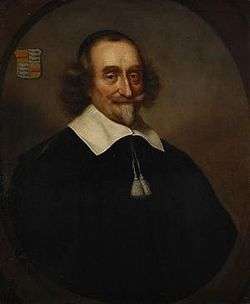Jan Bicker
| Jan Gerritsz Bicker | |
|---|---|
 | |
| Schepen of Amsterdam | |
|
In office 1647–1653 | |
| Burgemeester of Amsterdam | |
|
In office 1653–1653 | |
| Personal details | |
| Born | 1591 |
| Died | 1653 |
| Political party | Dutch States Party |
| Religion | Dutch Reformed |
Jan Gerritsz. Bicker (Amsterdam, 1591 – Amsterdam, 1653) was a merchant, a mayor (burgomaster) and a member of the Bicker family, an influential patrician family from Amsterdam.
The son of Gerrit Bicker, he was a shipbuilder and merchant in Amsterdam. His trade mainly was focussed on the Levant. Jan Bicker was the cities inspector of the ropes, and in 1647 he became Schepen. His brothers Cornelis and Andries Bicker were influential merchants and burgemeesters of the city. His older brother Jacob was lord of Engelenburg. When stadtholder William II attacked the city in 1650, one of his demands was that the Bickers voluntarily resigned their positions. The brothers were never burgemeester at the same time, but they had made agreements about an alliance, the so-called Bickerse ligue. After William II died in that same year, the Bickers regained their position during the First Stadtholderless Period. When Andries died, Jan was given the position of burgemeester, but did not keep it for long.
Personal life
Bicker was married to Agneta de Graeff van Polsbroek, a sister of Cornelis de Graeff. Three daughters were born from this marriage: Geertrui, Wendela and Jacoba Bicker. Geertruid married Jean Deutz, Wendela married Johan de Witt and Jacoba was the wife of her cousin Pieter de Graeff.[1] De Bickers were part of the staatsgezinde partij (the pro-republican party) and opponents of the stadtholders, who belonged to the House of Orange-Nassau. Jan Bickers son in law, the influential Grand Pensionary Johan de Witt practically controlled the Republic during the First Stadtholderless Period from 1650-1672. Several ownerships of Jan Bicker, amongst which the countryhouse 'De Eult' in Baarn, eventually fell into the hands of the stadtholders.
Career
Jan Bicker was for his time a wealthy man.[2] Aside from Baarn he also had countryhouses in Beverwijk: Akerendam (1637) and Duynwijck. Within the city of Amsterdam, Jan Bicker owned almost an entire island, called the Bickerseiland.[3] He bought the island in 1631 and had an enormous house with a high tower built there so that he could see his ships arrive. He lived on Keizersgracht (221).[4]
References
- ↑ Amsterdam City archive
- ↑ Rowen, Herbert H. (November 13, 2003). John de Witt: Statesman of the "True Freedom". Cambridge University Press. pp. 48–. ISBN 978-0-521-52708-8.
- ↑ Amsterdam City Archives
- ↑ http://www.amsterdamsegrachtenhuizen.info/grachten/kgo/kgo2990/kg07221/